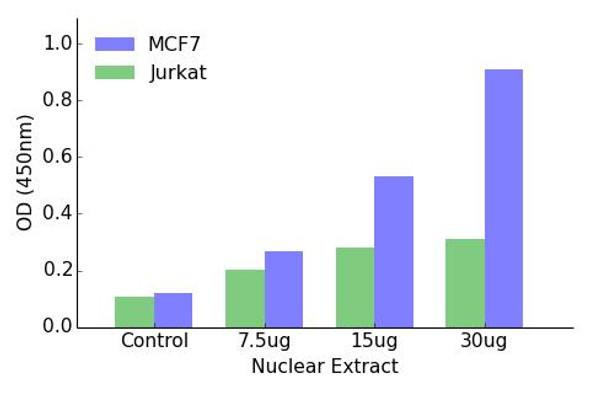Description
| Product Name: | AP-2 Transcription Factor Activity Assay |
| Product Code: | TFAB00080 |
| Target: | AP-2 |
| Synonyms: | AP-2 transcription factor, Activating enhancer-binding protein 2-alpha, Activator protein 2, AP-2 |
| Reactivity: | Human, Mouse, Rat |
| Sample Types: | Nuclear or cell lysates |
The Assay Genie AP-2 transcription factor activity assay allows for the detection and qualitative analysis of endogenous levels of activated transcription factors in a variety of nuclear and cell lysates
Assay Genie ELISA kits are designed to significantly reduce experiment time and ensure sensitivity and flexibility for high-throughput screening.
| Assay Time: | 4.5 hours |
| Detection Method: | Colorimetric 450 nm |
| Size: | 12 x 8-Well Microstrips |
| Storage: | 4°C for 6 months |
| UniProt Protein Function: | AP-2 alpha: Sequence-specific DNA-binding protein that interacts with inducible viral and cellular enhancer elements to regulate transcription of selected genes. AP-2 factors bind to the consensus sequence 5'-GCCNNNGGC-3' and activate genes involved in a large spectrum of important biological functions including proper eye, face, body wall, limb and neural tube development. They also suppress a number of genes including MCAM/MUC18, C/EBP alpha and MYC. AP-2-alpha is the only AP-2 protein required for early morphogenesis of the lens vesicle. Together with the CITED2 coactivator, stimulates the PITX2 P1 promoter transcription activation. Associates with chromatin to the PITX2 P1 promoter region. Binds DNA as a dimer. Can form homodimers or heterodimers with other AP-2 family members. Interacts with WWOX. Interacts with CITED4. Interacts with UBE2I. Interacts with RALBP1 in a complex also containing EPN1 and NUMB during interphase and mitosis. Interacts with KCTD1; this interaction represses transcription activation. Interacts (via C-terminus) with CITED2 (via C-terminus); the interaction stimulates TFAP2A- transcriptional activation. Interacts (via N-terminus) with EP300 (via N-terminus); the interaction requires CITED2. Belongs to the AP-2 family. 3 isoforms of the human protein are produced by alternative splicing. |
| UniProt Protein Details: | Protein type:DNA-binding; Transcription factor Chromosomal Location of Human Ortholog: 6p24 Cellular Component: nucleoplasm; Golgi apparatus; centrosome; intracellular membrane-bound organelle; cytoplasm; nucleus Molecular Function:protein dimerization activity; protein binding; protein homodimerization activity; sequence-specific DNA binding; transcription coactivator activity; chromatin binding Biological Process: negative regulation of epidermal growth factor receptor signaling pathway; transcription from RNA polymerase II promoter; embryonic forelimb morphogenesis; neural crest cell development; regulation of neuron differentiation; positive regulation of transcription, DNA-dependent; negative regulation of transcription from RNA polymerase II promoter; palate development; embryonic pattern specification; negative regulation of cell proliferation; sympathetic nervous system development; sensory perception of sound; oculomotor nerve formation; regulation of cell differentiation; epidermis morphogenesis; positive regulation of neuron apoptosis; negative regulation of neuron apoptosis; kidney development; inner ear morphogenesis; trigeminal nerve development; anterior neuropore closure; embryonic cranial skeleton morphogenesis; positive regulation of bone mineralization; embryonic body morphogenesis; forebrain neuron development; positive regulation of transcription from RNA polymerase II promoter; negative regulation of transcription, DNA-dependent; negative regulation of apoptosis; positive regulation of cell migration Disease: Branchiooculofacial Syndrome |
| NCBI Summary: | The protein encoded by this gene is a transcription factor that binds the consensus sequence 5'-GCCNNNGGC-3'. The encoded protein functions as either a homodimer or as a heterodimer with similar family members. This protein activates the transcription of some genes while inhibiting the transcription of others. Defects in this gene are a cause of branchiooculofacial syndrome (BOFS). Three transcript variants encoding different isoforms have been found for this gene.[provided by RefSeq, Dec 2009] |
| UniProt Code: | P05549 |
| NCBI GenInfo Identifier: | 135302 |
| NCBI Gene ID: | 7020 |
| NCBI Accession: | P05549.1 |
| UniProt Secondary Accession: | P05549,Q13777, Q5TAV5, Q8N1C6, |
| UniProt Related Accession: | P05549 |
| Molecular Weight: | 47,440 Da |
| NCBI Full Name: | Transcription factor AP-2-alpha |
| NCBI Synonym Full Names: | transcription factor AP-2 alpha (activating enhancer binding protein 2 alpha) |
| NCBI Official Symbol: | TFAP2A |
| NCBI Official Synonym Symbols: | AP-2; BOFS; AP2TF; TFAP2; AP-2alpha |
| NCBI Protein Information: | transcription factor AP-2-alpha; AP2-alpha; activator protein 2; AP-2 transcription factor; activating enhancer-binding protein 2-alpha |
| UniProt Protein Name: | Transcription factor AP-2-alpha |
| UniProt Synonym Protein Names: | AP-2 transcription factor; Activating enhancer-binding protein 2-alpha; Activator protein 2; AP-2 |
| Protein Family: | Transcription factor |
| UniProt Gene Name: | TFAP2A |
| UniProt Entry Name: | AP2A_HUMAN |






